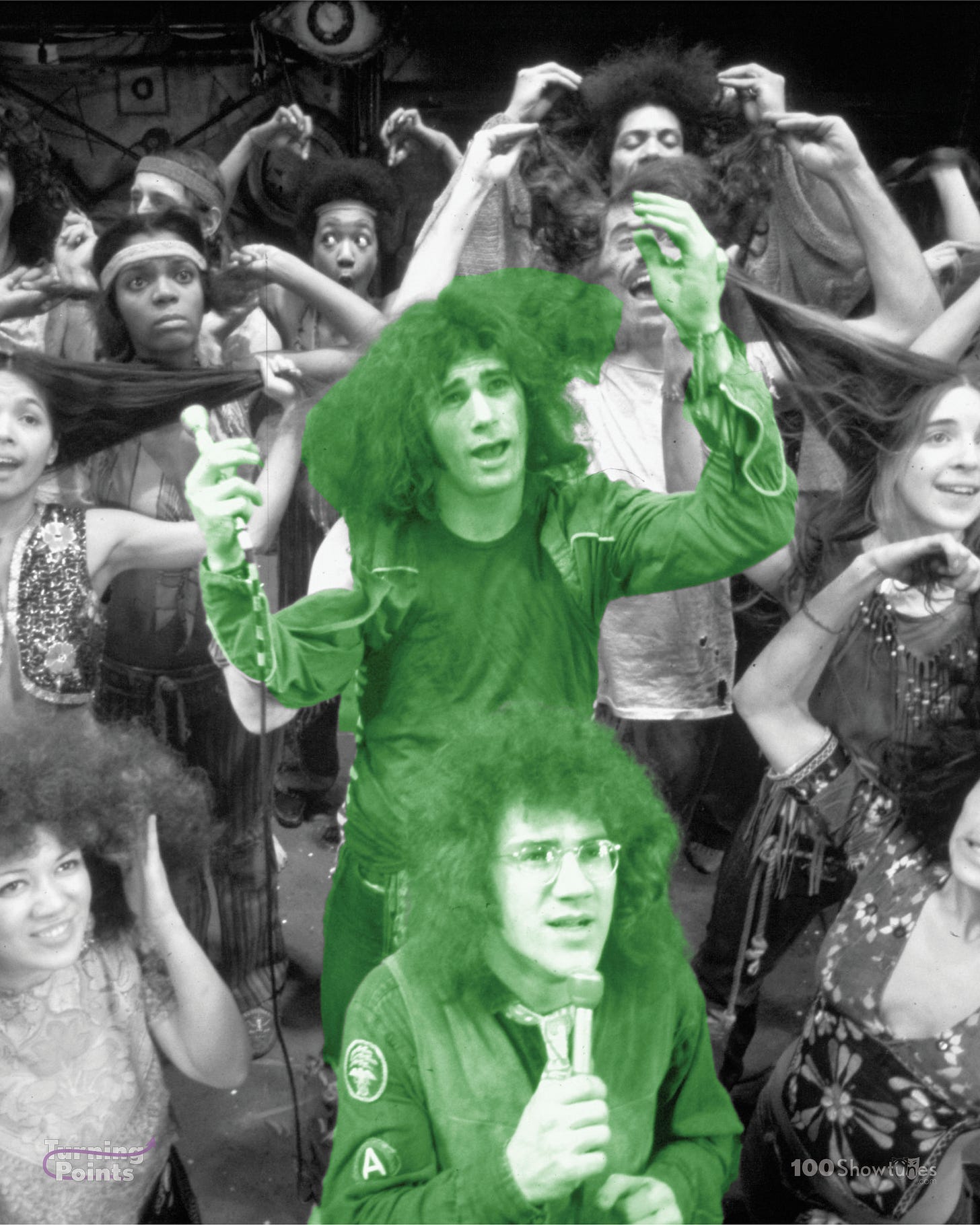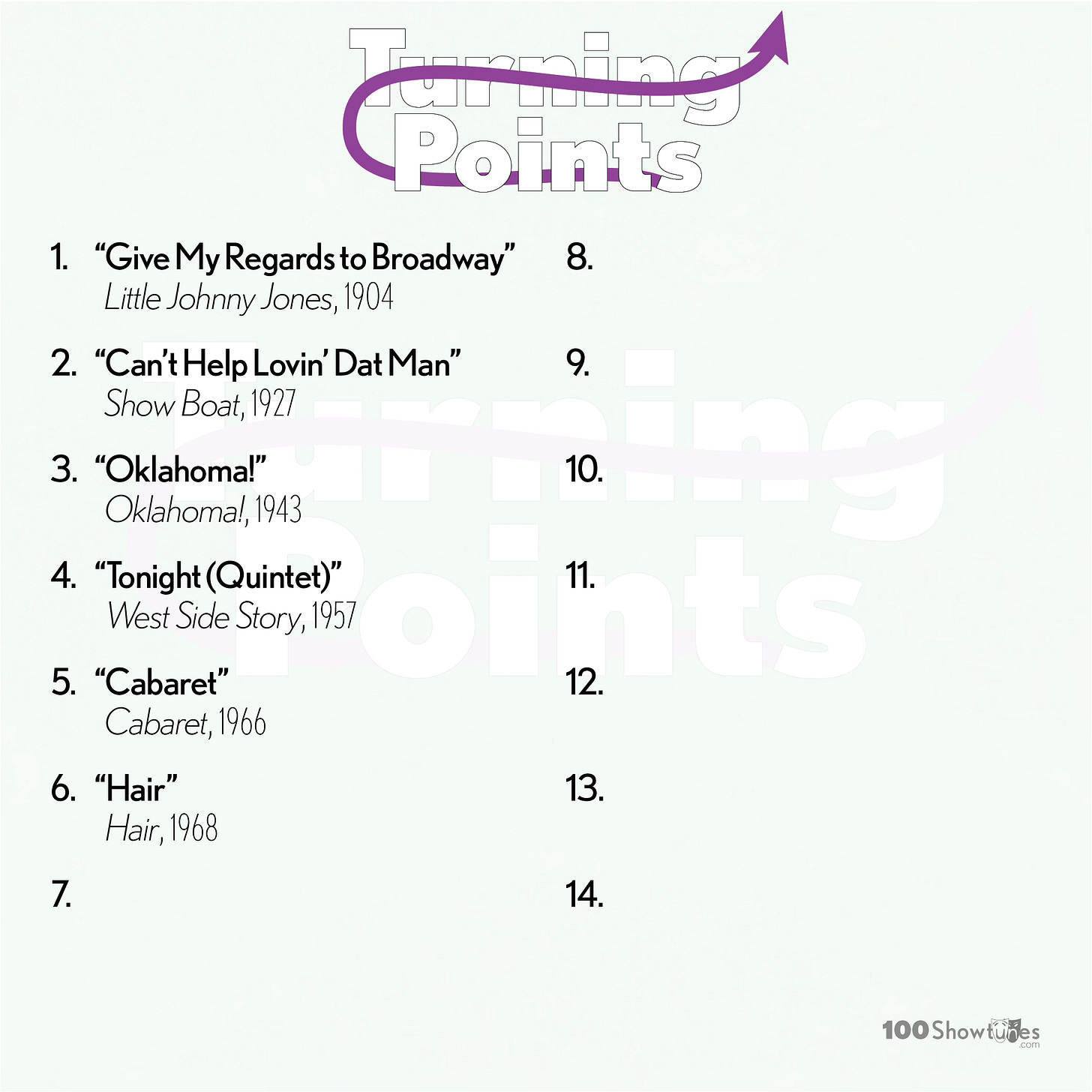No. 6. “Hair”
HAIR (1966). By Galt MacDermot (music) and Gerome Ragni and James Rado (lyrics and book).
Summer 1968. When you take your seat in the audience of Hair, you are surprised to see a nearly bare stage with no curtain and an exposed fly area. The set is a skeletal abstraction covered with random brick-a-brac. A cast of free-spirited hippies (whom the show refers to as the “tribe”) mingles with the audience as a young man sits center stage. The cast soon welcomes the audience to the Age of Aquarius (which doesn’t really mean anything, but it sounds terrific). The cast hangs out extolling counter-culture virtues (sex, drugs, world peace), and it’s as if you’re at a “Be-In.” Or at least what you imagine a “Be-In” is like. As much as the production wants to you feel like part of the “tribe,” you can’t help but sense you’re actually pobably more like one of the “squares” these kids are opposing. But you’re having fun! The young man from center stage at the opening is Claude. His best friend is the loin-cloth wearing Berger. Partway through the first act, two purported normies come up from the audience and ask why all the guys are so shaggy. Claude and Berger sing the joyous title song (“Hair”). The loosely structured evening eventually coalesces into a story about Claude, his draft card, and his death in Vietnam.
Up to this point, the Turning Points we have explored came from pedigreed creators thoughtfully and respectfully breaking convention. Hair’s director, Tom O’Horgan, quite literally found cast members and scenery on the street and put it all on a Broadway stage. It embraced not only the music, but the spirit of rock and roll just as Broadway needed it most. While much of the early days of recorded music, film, television felt like different ways of capturing the theatrical experience, by the 1960s they had all independently evolved into exciting and accessible playgrounds for innovation, while the American Musical was still a formal, often stodgy affair. Hair brought a renegade energy to the Great White Way, made Broadway relevant to younger generations, and became the source for massive pop hits with “Hair,” “Aquarius / Let the Sunshine In” and “Good Morning Starshine.” For all its freewheeling youthful energy, Hair was a dead-serious anti-war statement from the creators. (I submit to the jury Exhibit A: their haunting 1969 Tony Awards performance.) But to some audience members, it was an opportunity to safely visit counter-culture and be titillated by drugs and a little bit of nudity before heading back to home in suburbia. The songs became something you’d hear on a variety show. But even if it lost its edge, Hair’s most enduring influence lies less in its style or views than in its structure: The show was more driven by an overall idea and experience than plot or character, which is the essence of what would soon come to be known as “The Concept Musical.”
Recommended Recording: ”Hair,” Hair (2004 Concert Cast)
This recording followed a benefit concert for the Actor’s Fund (now the Entertainment Community Fund), organized and conducted by Seth Rudetsky. The concert featured different performers for each number, rather than a consistent “cast” that performed the same roles throughout the evening. At the time, Hair was considered “unrevivable” by many, and this was the first major American recording in at least 25 years. I’ve listened to every version of “Hair” I can find, and I am confident this is the best one out there. Raul Esparza is ideal on the title number (joined by an also excellent Harris Doran), and everything about it hits the way I want it to.
Alternate Performances
Hair has recieved ~62 cast recordings. A 1968 German Cast Recording features Donna Summer as the soloist on “Aquarius.” The Cowsills, a family band as alternative as apple pie, has a number one hit with the title song. The Minions also have a version.
1967 Original Off-Broadway Cast: Hair began at the New York Shakespeare Festival (aka The Public Theater) in a production directed by Gerald Freedman1 with a different creative team and a number of different cast members than what would eventually appear on Broadway. Co-lyricist/librettist Gerome Ragni plays Berger. It’s fascinating to hear this earlier draft, and note the subtle changes that turned this version into the one we’re familiar with today.
1968 Original Broadway Cast: The OBCR is a definitive performance of the score and a time capsule of the late 1960s. Co-librettist James Rado plays Claude and Gerome Ragni again plays Berger. The ensemble includes the likes of Diane Keaton, songwriter Paul Jabara (“Last Dance,” “It’s Raining Men”), and both of Martha Plimpton’s parents (who met in the show). The recording was certified Gold ten months after it was recorded.
1979 Film: Directed by Milos Forman, the Hair movie converted the largely atmospheric stage piece into a linear drama with a new screenplay by playwright Michael Weller. The movie retains the character names and basic idea of the Broadway show, but creates a largely new narrative with different contexts for many songs. “Hair” is sung by a character named Woof (Don Dacus) after he and other lead hippies are arrested for crashing a fancy dinner. The score is well adapted, and it’s a great sounding album with some fun appearances from the likes of Treat Williams, Nell Carter, Charmaine Woodard, Laurie Beechman, Beverly D’Angelo, and Betty Buckley (dubbing the vocals of Vietnamese actress Linda Surh).
2009 Broadway Revival: Aside from a brief return engagement of the original production, the Great White Way didn’t get any new Hair until a 2009 Revival directed by Diane Paulus. It managed to successfully capture the appropriate tone, feeling like an organic gathering of flower children rather than some Spirit Halloween version of hippie culture. It began as part of the Public Theater’s free Shakespeare in the Park series before running on Broadway for over a year. Gavin Creel and Will Swenson sing the title number. Creel sadly passed away (far too young) last year, and listening to this recording is bittersweet in a way no one ever intended.
Is it Covered by The Rat Pack, Audra McDonald, or Glee?
Rat Pack: Sammy Davis Jr. recorded an unreleased version of “Aquarius,” but otherwise The Rat Packed avoided Hair.
Audra McDonald has not recorded any songs from Hair, but in 2012 she married to Will Swenson (Berger form the 2009 revival).
Glee: Season 1 Episode 11 (“Hairography”) features a mash-up of “Hair” and Beyoncé’s “Crazy in Love” that New Directions performs as part of a scrimmage match against rival choruses. (It doesn’t go over well.)
In the Wings
Song No. 7 drops next week, which will bring us to the halfway point of our first playlist! In the meantime, you may want to check out a special Hair-themed episode of Head of the Class (a sitcom I vaguely remember and assumed I made up) in which guest star Elaine Stritch tries to sabotage a high school production of Hair.
Cleveland Shout-out! Freedman was born in Lorain and served as the artistic director of Great Lakes Theater Festival for 12 years. They continue to remount his 1989 production of A Christmas Carol annually.





I loved doing Hair back in 1982. My Uncle died in the Vietnam War, and it was so hard getting through the last number in the show. GREAT MUSICAL! Donald, you do such a great job